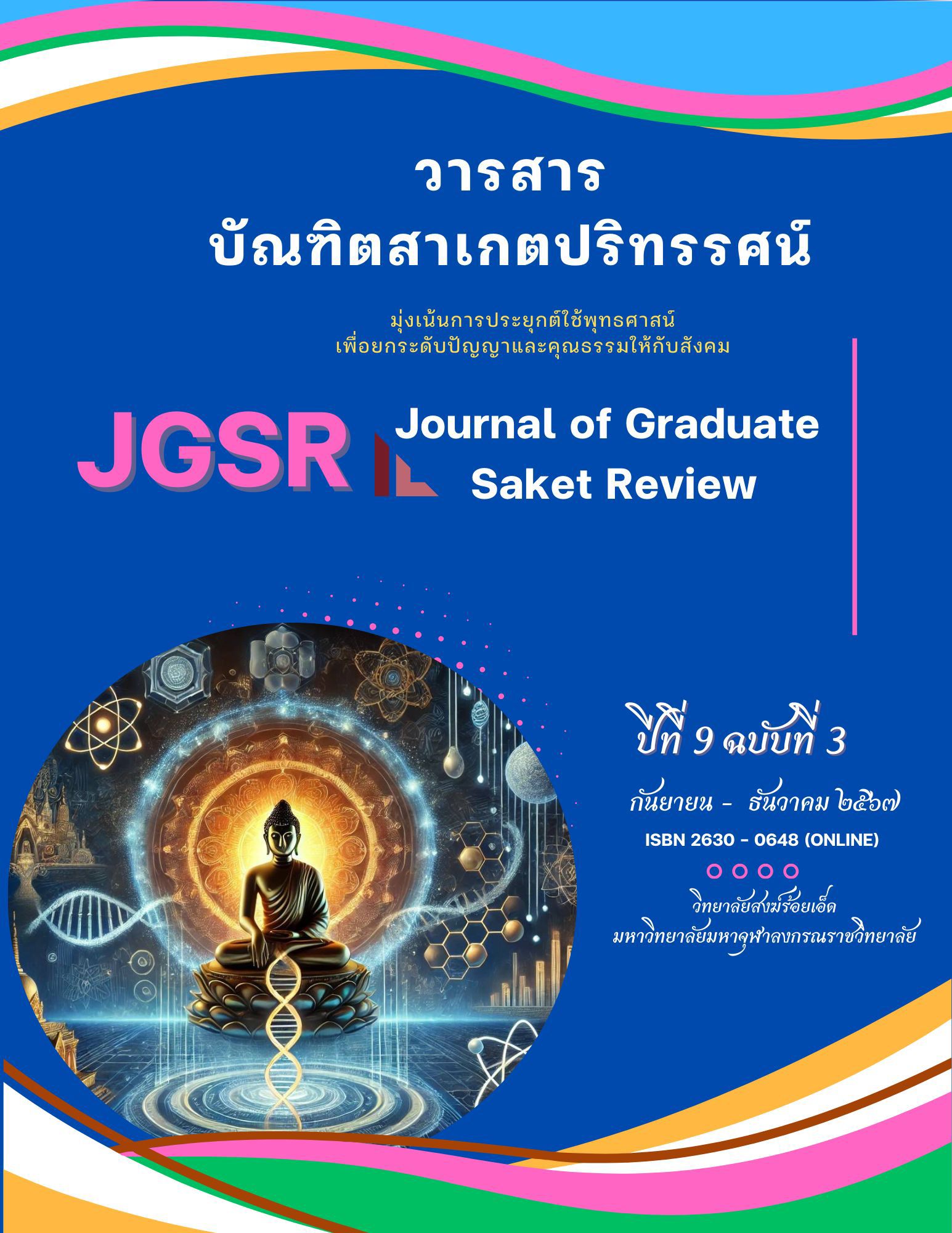Developing Creative Thinking Skills with Augmented Reality (AR) Technology on Human Rights for Grade 9 Students
Main Article Content
Abstract
The objectives of this research are: 1) to examine the effects of developing creative thinking skills using Augmented Reality (AR) technology on human rights for Grade 9 students, and 2) to study students' satisfaction with learning management using Augmented Reality (AR) technology. This is applied research. The target group for the study consisted of 44 Grade 9 students from Class 4, selected through purposive sampling. The research instruments included: 1) a learning management plan, 2) a creative thinking product evaluation form, and 3) a satisfaction evaluation form, with the quality of the instruments being assessed by reliability. The statistical methods used for data analysis were percentage, mean, and standard deviation.
Results:
1. The development of creative thinking skills using Augmented Reality (AR) technology showed that the overall improvement in students' creative thinking skills was not less than 80%.
2. Students' satisfaction with learning management using Augmented Reality (AR) technology was at the highest level overall. The integration of AR technology into teaching and learning made the content more engaging and interesting, allowing students to design their projects based on their own ideas.
The study suggests that AR technology can help enhance learning outcomes, especially in subjects that are difficult to understand.
Article Details

This work is licensed under a Creative Commons Attribution-NonCommercial-NoDerivatives 4.0 International License.
เนื้อหาและข้อมูลในบทความที่ลงตีพิมพ์ในวารสารบัณฑิตสาเกตปริทรรศน์ ถือเป็นข้อคิดเห็นและความรับผิดชอบของผู้เขียนบทความโดยตรงซึ่งกองบรรณาธิการวารสาร ไม่จำเป็นต้องเห็นด้วย หรือร่วมรับผิดชอบใด ๆบทความ ข้อมูล เนื้อหา รูปภาพ ฯลฯ ที่ได้รับการตีพิมพ์ในวารสารบัณฑิตสาเกตปริทรรศน์ ถือเป็นลิขสิทธิ์ของวารสารบัณฑิตสาเกตปริทรรศน์ หากบุคคลหรือหน่วยงานใดต้องการนำทั้งหมดหรือส่วนหนึ่งส่วนใดไปเผยแพร่ต่อหรือเพื่อกระทำการใด ๆ จะต้องได้รับอนุญาตเป็นลายลักอักษรจากวารสารบัณฑิตสาเกตปริทรรศน์ ก่อนเท่านั้น
References
ภาษาไทย
กระทรวงศึกษาธิการ.(2567). แผนการขับเคลื่อนการดำเนินงานของสำนักงานปลัดกระทรวงศึกษาธิการตาม นโยบายและจุดเน้นของกระทรวงศึกษาธิการ. กรุงเทพมหานคร: ม.ป.ท.
จรัสพร บัวเรือง. (2562). การพัฒนาชุดความคิดสร้างสรรค์แบบนำตนเอง. วิทยานิพนธ์ศึกษาศาสตรมหาบัณฑิต สาขาวิชาหลักสูตรและการสอน. วิทยาลัยครุศาสตร์: มหาวิทยาลัยธุรกิจบัณฑิตย์.
พีรวิชญ์ คําเจริญ และ วีรพงษ์ พลนิกรกิจ. (2563). การศึกษาพฤติกรรมการใช้สื่อดิจิทัล และทักษะการรู้เท่าทันดิจิทัลของนักเรียนชั้นประถมศึกษาตอนต้น. วารสารวิชาการนวัตกรรมสื่อสารสังคม. 8(1), 55-66.
ภานุวัฒน์ กาหลิบ และคณะ. (2565). การสร้างสรรค์เทคโนโลยีเสมือนจริง จากการออกแบบภาพสัญลักษณ์ และระบบป้ายภายในวัดเทพธิดารามวรวิหาร. รายงานการวิจัย. มหาวิทยาลัยราชภัฏสวนสุนันทา.
รัฐพล ประดับเวทย์. (2560). แนวทางการจัดกิจกรรมการเรียนรู้ด้วยเทคโนโลยีตามแนวคิดอนุกรมวิธาน ของบลูม. วารสารมหาวิทยาลัยศิลปากร. 10(3), 1053-1065.
สุภาวิตา ทับบุรี. (2562). การพัฒนาหนังสือเรียนโดยใช้เทคโนโลยีความจริงเสริม กลุ่มสาระการเรียนรู้สังคม ศึกษา ศาสนาและวัฒนธรรม เรื่อง ภูมิศาสตร์ทวีปอเมริกาเหนือสำหรับนักเรียนชั้นมัธยมศึกษาปีที่ 3 โรงเรียนสตรีอ่างทอง จังหวัดอ่างทอง. การศึกษาอิสระ สาขาวิชาศึกษาศาสตร์มหาวิทยาลัยสุโขทัยธรรมาธิราช.
สำนักงานคณะกรรมการสิทธิมนุษยชนแห่งชาติ. (2563). แผนสิทธิมนุษยนชนแห่งชาติ. กรุงเทพมหานคร: ม.ป.ท.
ภาษาอังกฤษ
Buaroeng C. (2019). The development of self-directed creative thinking sets. Master of Education Department of Curriculum and Instruction. College of Education: Dhurakij Pundit University.
Guilford, J. P. (1967). Creativity: Yesterday, today, and tomorrow. The Journal of Creative Behavior. 1(1), 3-14.
Kalib P., Maneewatthana C., Rattanachaiwong N., and Phimsarn P. (2022). The creation of virtual technology from the design of symbolic images and signage systems within Thepthidaram Temple. Suan Sunandha Rajabhat University.
Khamcharoen p. and Ponnikornkit W. (2020). A study of digital media usage behavior and digital literacy skills of primary school students. Journal of Social Communication Innovation. 8(1), 55-66.
Likert, Renic. (1993). A Technique for the Measurement of Attitude. Chicago : Read Mc. Nally.
Ministry of Education. (2024). Action Plan for the Operation of the Office of the Permanent Secretary, Ministry of Education, in accordance with the Policies and Focus Areas of the Ministry of Education. Bangkok: n.p.
Office of the National Human Rights Commission. (2020). National Human Rights Plan. Bangkok: n.p.
Pradubwet R. (2017). Guidelines for organizing learning activities with technology based on Bloom's taxonomy. Silpakorn University Journal. 10(3), 1053-1065.
Thapburi S. (2019). The development of textbooks using augmented reality technology in the social studies, religion, and culture learning group, North American geography for Grade 9 students, Angthong Female School, Angthong Province. An Independent Study. Faculty of Education: Sukhothai Thammathirat Open University.


